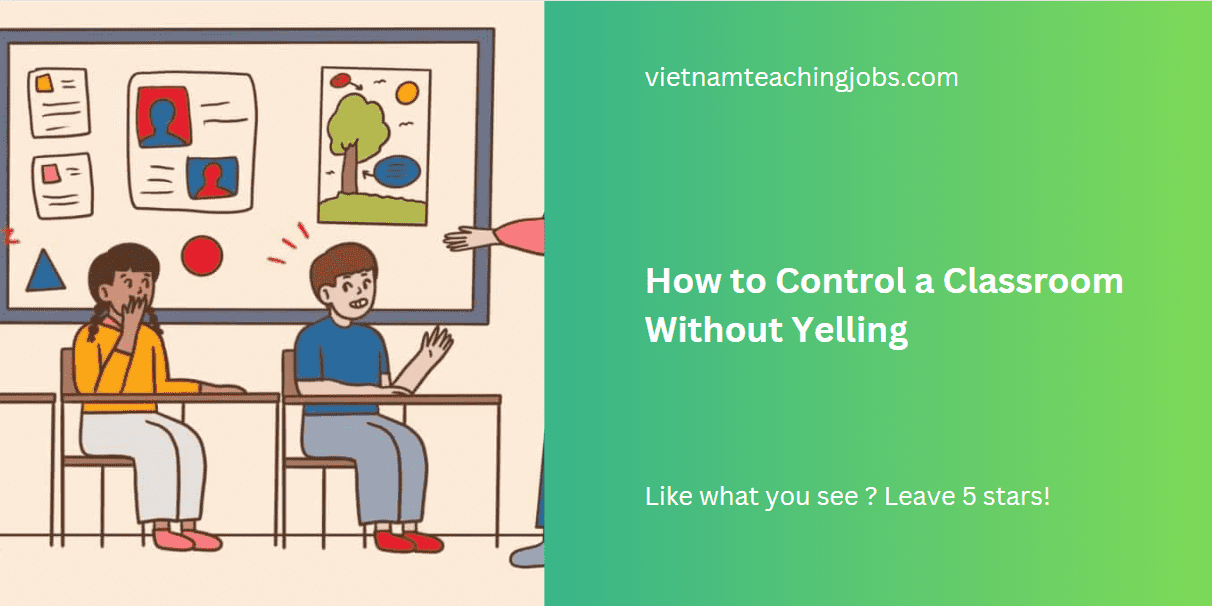How to control a classroom without yelling? It’s a question many teachers ask themselves. Let’s VTJ discover some helpful techniques.
 [Effective Strategies] How to Control a Classroom Without Yelling
[Effective Strategies] How to Control a Classroom Without Yelling
How to control a classroom without yelling?
Yelling in the classroom can be stressful for both teacher and students. Luckily, there are many effective classroom management techniques that build a positive learning environment. Here are some tips:
Clear Expectations
Set clear rules and procedures at the beginning of the year and revisit them regularly. Make sure students understand what is expected of them behaviorally and academically.
- Routines: Establish routines for entering and exiting the classroom, transitions between activities, and using materials. This predictability helps students know what to expect and reduces uncertainty.
- Positive reinforcement: Catch students being good! Acknowledge and praise students who are following the rules and participating positively.
Proactive Communication
- Proximity & non-verbal cues: Sometimes, just moving closer to a student who is starting to get off track can be enough to refocus them. A stern look or a raised eyebrow can also be a silent cue.
- Calm voice: Even if a situation is frustrating, try to speak to students in a calm and firm voice. This shows you are in control and allows students to hear your message.
- Active listening: If a student is disruptive, take a moment to listen to their perspective. Understanding why they are acting out can help you address the root cause.
Responding to Disruptions
- Private conversations: Address disruptive behavior privately whenever possible. This avoids putting a student on the spot and allows for a more productive conversation.
- Logical consequences: Establish consequences for breaking the rules that are fair and related to the behavior. This is more effective than yelling and helps students learn from their mistakes.
- Positive relationships: Building positive relationships with students goes a long way in creating a respectful classroom environment. Take time to get to know your students and show that you care about them.
Remember, classroom management is an ongoing process. There will be bumps along the road, but by using these techniques, you can create a positive learning environment without resorting to yelling.
Read more: 6 Tips for Managing Student Behavior in the Classroom
How to prevent student misbehavior?
 To prevent misbehavior, set clear rules, routines, and positive reinforcement systems, engage students with relevant lessons, and build positive relationships
To prevent misbehavior, set clear rules, routines, and positive reinforcement systems, engage students with relevant lessons, and build positive relationships
The best classroom management involves preventing misbehavior before it starts. Here are some key strategies to create a positive and productive learning environment:
Lay the groundwork early
- Clear Expectations: Establish clear rules and procedures at the beginning of the year and revisit them regularly. Make sure they are age-appropriate and posted in the classroom for easy reference.
- Routines & Predictability: Create routines for entering and exiting the classroom, transitioning between activities, and using materials. This predictability helps students feel safe and know what to expect.
- Positive Reinforcement System: Focus on catching students being good! Acknowledge and praise students who are following the rules and participating positively. This can be verbal praise, a sticker system, or a classroom point system with rewards.
Design engaging lessons
- Varied Instruction: Mix up lectures, discussions, group activities, and hands-on projects to cater to different learning styles and keep students engaged.
- Relevance & Choice: Whenever possible, connect the learning material to students’ interests or offer choices within assignments. This fosters a sense of agency and makes learning more relevant.
- Movement Breaks: Schedule short movement breaks throughout the lesson, especially for younger students. This can help them refocus and release energy.
Build positive relationships
- Get to know your students: Take time to learn about their interests, strengths, and challenges. This personal connection builds trust and respect.
- Active Listening: If a student is disruptive, take a moment to listen to their perspective. Understanding the root cause can help you address the issue effectively.
- Positive Classroom Culture: Create a classroom culture that celebrates learning, effort, and collaboration. This will motivate students and make them feel like they are part of a supportive community.
How to control a classroom without yelling? In conclusion, there are numerous methods available for controlling a classroom without resorting to yelling. By implementing these strategies, teachers can create a positive and conducive learning environment where students feel respected and motivated to succeed.
Read more: What Are the Responsibilities of Teacher? (2024 Guide)
FAQs

To manage stubborn students, engage in calm conversations, listen actively, relate lessons to their interests, offer choices, and highlight strengths
How to handle problematic students?
Follow these tips from the article, and you’ll be great at handling your students’ behavior. Here’s what to do with even the toughest kids:
- Stay calm & professional: It’s important to stay calm and professional when dealing with disruptive behavior. Don’t take it personally, and focus on finding solutions.
- Consistency is key: Be consistent with your expectations and follow-through with consequences. This helps students understand what is expected of them.
- Positive reinforcement: Don’t forget the power of positive reinforcement! Acknowledge and praise the student when they are following the rules and meeting expectations.
If you’re still struggling with a particular student, don’t hesitate to reach out to your school administration or colleagues for additional support.
How to handle stubborn students?
Stubborn students can be a challenge, but there are ways to navigate their resistance and get them engaged in learning. Here are some tips:
- Try to have a calm conversation with the student to understand why they’re resistant.
- Actively listen to their perspective and acknowledge their feelings.
- Find ways to connect the learning material to their interests.
- Offer choices within assignments or projects whenever possible. This gives them a sense of agency and ownership over their learning.
- Highlight the student’s strengths and build on them. This can boost their confidence and make them more receptive to challenges.
How to deal with a student who doesn’t care?
What if a student doesn’t seem to care? Here’s what you can do:
- Talk to them calmly.
- Find out what’s bothering them.
- Show them you care about their feelings.
- Set clear expectations for behavior.
- Offer rewards for good behavior.
- Get help from a counselor if things don’t improve.
Read more: Didactic Teaching: Differences between Didactics and Pedagogy?
So, you can see, managing how students behave is really important to have a fun and effective classroom. Teachers need to have the basic knowledge and understanding to make teaching smooth and effective.




